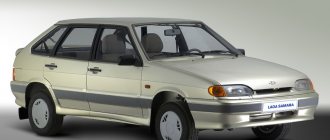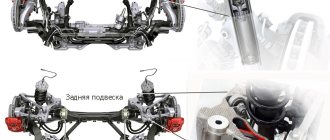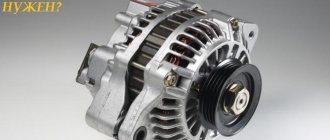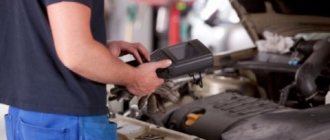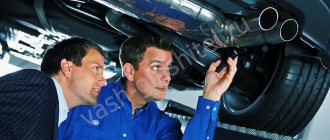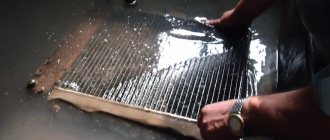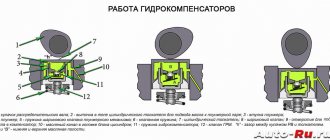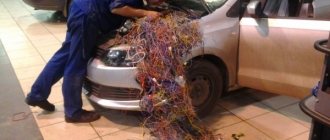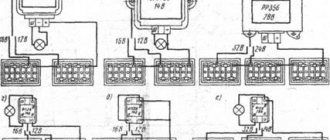An important step in getting to know the car you want to buy second hand is checking the car’s chassis. The chassis is a large set of mechanisms, some parts here are consumables, since this part of the machine is movable, and its elements are directly responsible for contact with the road, steering, and much more.
Even if the car is legally clean, and everything is in order with the main units like the engine, this is not a reason to rush out and buy it - look under the bottom, there are also enough vital elements for the car.
Those who are not ready to spend money on diagnostic services at a service center, while reading, thought about it - how to independently check the chassis of a car? We will tell you about this in detail.
What is a chassis
This is a special synthesis of components and assemblies that contribute to the movement of the vehicle.
Chassis device:
- Front suspension;
- Rear suspension;
- Wheels.
Suspensions are needed in order to dampen or soften vibrations while driving off-road or over bumps. It is thanks to the suspension that the car smoothly overcomes all the unevenness of the road surface. It is important that the wheels of the car are rigidly coupled to the body part; only in this case can maximum driving safety be ensured. Therefore, the chassis of the machine must be strong and durable, with well-rotating joints.
Diagnostics of the running system condition
When purchasing a car that is not new, it is necessary to diagnose the car’s chassis, mechanisms and parts as soon as possible. In the process of purchasing a car, the best option is to test the car in motion in order to find out all the shortcomings of the running gear. The vehicle will not cost you less, but you can invest this money in repairs.
The vehicle must be checked periodically, without waiting for unpleasant or incomprehensible noises, knocking, squeaking, tire wear while the car is moving, or pulling to the left or right during braking.
When performing maneuvers, there is a feeling of play in the steering wheel (steering column). Neglecting such points can lead, at best, to catastrophic consequences, both for your vehicle and for the integrity of the vehicle of your neighbors on the road. Many experts give different figures between diagnostics, but on average it is from fifteen to twenty-five thousand km, and it also depends on the operating conditions of the vehicle.
Timely diagnosis of those responsible for the movement of units will help identify wear or breakdown of components for timely replacement or repair, which will subsequently provide you with comfort and safety when driving.
Diagnostics of the running system mechanisms consists of:
- Checking the springs, their support cups, the operation of shock absorbers (checked using a special device, since it is impossible to visually check the level of wear).
- ball joints and boots, checking the lateral stabilization rods/levers and silent blocks in them, which ensures smooth movement of the car.
- steering rack (for play), hydraulic system.
- checking the brake system (pads, drums, hoses).
- camber/toe (which affects tire wear).
Electronic diagnostics
After a visual and physical check, it is also recommended to diagnose the car using computer equipment, carried out at a special stand. It will allow you to determine in more detail the malfunctions of the vehicle's chassis and wear down to fractions of a mm. After diagnosing the running gear parts, the expert will give you a conclusion with a list of components and assemblies that need to be repaired or completely replaced . Diagnostics should be carried out in professional and specialized car services. When repairing or replacing parts, it is advisable to use original spare parts and use professional tools, which in turn will ensure a long service life of the replaced units and significantly save part of your financial well-being.
Suspension fault
A faulty vehicle chassis can lead to the most unpredictable and disastrous consequences - from vehicle skidding to accidents. To avoid such excesses, it is important to know the suspension design and be able to independently determine the failure of this important bunch of parts.
If, while driving, when changing gears, the driver detects extraneous noise, this is a signal. Often the reason for such sounds lies in a malfunction of the chassis.
The chassis design assumes that the suspension becomes a transmission link from the car body to the road surface. It is important that the trajectory of the wheels is identical, while the body is usually isolated from extraneous noise.
How is all this secured?
The hub is attached to the wheel using four levers. This allows the car wheel to move freely in the transverse and longitudinal plane. The supporting element in the design of this suspension is the subframe.
The transverse arm is attached to it through special bushings with a metal base. To reduce vibrations, they use rubber. The transverse arms are connected to the hub support. This ensures the correct position of the wheels in the transverse plane. Often, a multi-link independent rear suspension includes three wishbones:
- Lower rear.
- Front.
- Upper.
The latter transmits forces and connects the subframe to the wheel support housing. The lower front suspension arm is responsible for toe-in. The rear element absorbs the forces that are transmitted from the body when the car moves. The steering of the wheel in the longitudinal position is carried out thanks to the trailing arm. It is attached to the car body using a support. On the other side, the element is connected to the hub.
A passenger car has four trailing arms - one for each wheel. The hub support itself is the base for the wheel and bearing. The latter is secured with a bolt. By the way, if the tightening torque is not observed, the bearing can be damaged. When making repairs, you should leave a slight play in the hub. Otherwise, your bearing will fall apart. Also, the multi-link front suspension has a coil spring in its design. It rests on the lower rear wishbone and absorbs forces from it. The shock absorber is located separately from the spring. It is usually connected to the hub support.
The most common problems associated with the chassis
The most common breakdowns of the chassis are:
- The car skids to the side. This problem arises for a number of reasons: when the geometry of the front wheels is violated, from surges in air pressure in the tire, due to deformation of the levers, when there is a large difference in wheel wear, when the parallelism of the axis of the rear and front axles is disrupted.
- The driver feels the car oscillate, sway when cornering and during braking. The reason for this may be failure of the shock absorbers or a broken spring or other suspension part.
- Excessive vibrations during driving indicate inadequate tire pressure, or wear on the wheel bearings or rear shock absorber, or a broken spring.
- While driving, you hear a knock from the suspension - pay attention to the shock absorber or wheel rims - they may have become unusable.
- A creaking or knocking sound from the shock absorber indicates that it is about to wear out; perhaps the casing has become deformed or the piston and reservoir fastenings have become loose. Inspect everything carefully for fluid leaks.
- If the tire tread is worn unevenly, the wheels may be out of balance. It is also important to check the hinges and bushings - they could become loose. Damaged discs and broken geometry of the front wheels often lead to this problem.
- During braking, a distinct creaking noise is heard - this indicates a malfunction of the shock absorber, stabilizer or mounting parts, or a sagging spring.
- Shock absorbers are leaking. It is necessary to check the rod seals; perhaps the liquid is leaking due to foreign particles getting on the edge of the seal.
- The shock absorber does not provide the required resistance during the compression stroke. This may be due to a leak in the valve, wear on the guide sleeve or the stem.
If at least one of the above symptoms is observed, immediate action must be taken.
Self-check of the car chassis
If you decide to check the car yourself, including seeing what is under its bottom, it is important to know what to look for - the car has four wheels around the perimeter, in the middle most often there are crankcase protection sheets, but this does not mean that you should not look there for what.
First of all, faulty suspension elements give themselves away by extraneous sounds. If extraneous sounds are heard below, the culprits requiring replacement or repair may be:
- Shock absorbers are an element that absorbs all the bumps and impacts from road potholes.
- Strut springs are constantly loaded, over time they inevitably “get tired” and require replacement;
- The CV boot - as the name suggests, protects the part from dust. If it is dirty or torn, it needs to be replaced.
- The support cups of the racks - by and large, simply must be intact and not deformed.
- Silent blocks are what connect various suspension parts. It consists of two metal bushings with a rubber insert in the middle. If there are strong vibrations from the suspension elements when driving, and the car is not very stable, questions should arise primarily to this element.
- Various backlashes can affect many chassis elements at once, be it CV joints, tie rod ends and much more.
It’s worth dwelling on some points in more detail to clarify the details, especially if many of these words have become something new for you.
Shock absorbers are the simplest thing; no special skills or abilities are needed here, and anyone can check their condition on the spot. To do this, just try to rock the car; if it rocks more than twice, the shock absorbers need to be replaced. To make sure that they are faulty, you can lift the car and inspect them from the side for leaks.
With springs it is somewhat more complicated - the fact that the springs have “sagged”, unfortunately, may not be visible to the naked eye. But it is very clearly visible if the spring is broken. And the height of the car’s suspension will give a hint if something happens - if the car is too low, then it’s worth paying attention.
With anthers everything is simple - if they are intact and clean, then we move on, if they are dirty or torn, or all of them - we change them. The part is not too expensive, even cheap (what can be expensive in a piece of rubber?), so torn and dirty boots can only be a cause for concern if the owner has been driving with them in this condition for a long time.
Chassis diagnostics
Chassis wear is one of the most common problems. Due to constant vibrations and vibrations, the walker fails. Therefore, it is very important to periodically carry out diagnostics every 20,000 km, or even faster. The chassis design of each car is the same, but the operating conditions are different. Therefore, if the car has not yet completed the measured mileage, but has been driven off-road or is showing signs of malfunction, it is better not to put off the check for a long time.
Diagnostics of the chassis must be carried out in specialized, proven car services in order to obtain accurate and reliable information. You should not do this yourself if you do not have qualifications and specialized equipment.
Variety of suspension options
The vehicle suspension device is an independent design solution of the manufacturer. There are several typologies of car suspension: they are distinguished by the criterion underlying the gradation.
Depending on the design of the guide elements, the most common types of suspension are distinguished: independent, dependent and semi-independent.
The dependent version cannot exist without one part - a rigid beam that is part of the car axle. In this case, the wheels move parallel in the transverse plane. The simplicity and efficiency of the design ensures its high reliability, preventing wheel alignment. That is why dependent suspension is actively used in trucks and on the rear axle of cars.
The independent suspension system of a car assumes that the wheels exist autonomously from each other. This improves the damping characteristics of the suspension and ensures a smoother ride. This option is actively used for organizing both front and rear suspension on passenger cars.
The semi-independent version consists of a rigid beam secured to the body using torsion bars. This scheme ensures relative independence of the suspension from the body. Its typical representative is the front-wheel drive VAZ models.
The second typology of suspensions is based on the design of the damping device. Experts distinguish hydraulic (oil), pneumatic (gas), hydropneumatic (gas-oil) devices.
The so-called active suspension stands apart. Its design includes variable capabilities - changing suspension parameters using a specialized electronic control system depending on the vehicle's driving conditions.
How does this happen
Modern diagnostics are carried out in several stages for greater reliability. Step by step it looks like this:
- The primary stage of testing is collecting all the necessary information from the car owner, which allows you to detect the problematic segment so as not to test the entire device;
- Then the vehicle is driven to a specialized stand;
- During the testing process, the car will be inspected on a lift;
- They will check it on the computer.
Usually, after checking, the car owner receives information about the condition of such parts as levers, springs, shock absorbers, support cups, steering ends, ball joints, wheel bearings, and assemblies.
Qualified technicians will inspect the hydraulic system, brake pads, hoses, discs and drums. After testing, they will give a conclusion and recommendations for repair.
Main suspension options
The design of a car's suspension is, of course, the prerogative of the manufacturer. However, at present, there are several main (most common) options for suspension systems, differing in the design of the guide elements:
Dependent suspension
The main structural element of this type of suspension is a rigid beam, which acts as a continuous bridge between the wheels (right and left). A characteristic feature of this element is the dependence (transmission of movement in the transverse plane) of one wheel from the other. Modern manufacturers use this type of suspension on light trucks, commercial vehicles, and also as a rear suspension on some SUV models.
The most widely used suspension is a dependent suspension, equipped with guide arms or based on longitudinal springs.
Repair of chassis
The chassis often malfunctions, so repairs are important and must be carried out in a timely manner, otherwise there is a risk of getting into a critical situation on the road. Based on the diagnostics conclusion, it becomes clear which parts of the chassis need to be repaired or replaced. The most common segments of chassis repair work are:
- Front suspension;
- Rear suspension;
- The need to replace the strut, spring or shock absorber
The following chassis components may need to be replaced:
- Silent block;
- Spherical bearing;
- Steering end;
- Steering rack;
- Steering gear;
- Wheel bearing;
- Grenade.
It is very important to purchase original spare parts for your car, otherwise repairs can become a nightmare for the car owner, and a waste of money - useless. By purchasing a low-quality or unsuitable part for a device, you can get a pig in a poke. The part may not fit, may not work as expected, or may fail very early without serving its useful life.
You should not skimp on diagnostics and repairs - a serviceable car is the key to your safety on the road.
Multi-link suspension device
The chassis of a car is a collection of parts and assemblies. In addition to other classifications, suspensions are divided into subtypes according to the number and location of levers. If the design uses two levers, the suspension is called double-wishbone, if more - multi-link. The levers can be located along, across the longitudinal axis of the machine, or at an angle relative to it. A multi-link suspension is characterized by a complex design and its cost is much higher than a two- or single-link suspension, while the designers managed to achieve close to ideal without deviations in the vertical plane and the effect of “steering” the movement of the wheel. As with any other type of system, guides, damping and elastic elements are used in the structure. Thus, the multi-link suspension device has a number of main components:
- Subframe or frame;
- Cross arms;
- Trailing arm;
- Hub support;
- Shock absorbers and springs.
The independent multi-link that modern cars are equipped with consists of three or five wishbones. The design also uses a stabilizer bar, which prevents swinging of the load-bearing part, reduces the body roll angle when cornering and ensures constant adhesion of the wheels to the road. The subframe (or frame) acts as a load-bearing structural element; transverse arms connected to the hub support are attached to it, which determines its transverse location. Depending on the type of system, shock absorbers and springs can be replaced by a pneumatic strut. The system also contains connecting elements - silent blocks and ball joints, with their help the levers are connected to the subframe.
When installed on a steered axle, the connection to the hub support is made using ball joints, which provide the hub with the ability to change its position angle. Silent block rubber mounts are used on the rear axle, but due to the emerging trend of steering rear wheels, ball elements can also be used. The Multilink suspension is rigidly fixed in relation to lateral and horizontal movement in the longitudinal direction, the car is provided with a smooth ride even on significant road unevenness, as well as excellent cornering. They install a multi-link on both the rear and front axles. In the second case, the levers can be replaced by reaction rods, which are capable of performing the tasks of a stability stabilizer and a lever.
Dependent, semi-independent (semi-independent) and independent suspension
Having examined the general structure, as well as the suspension elements, it becomes clear that the suspension itself can be different in design. In other words, the rear suspension design and the front suspension design may differ significantly.
Let's move on. The type of suspension is determined by the design features of the guide elements in its design.
In fact, there are two main types of car suspension:
- independent vehicle suspension;
- dependent suspension on cars;
Experts also distinguish the so-called semi-independent suspension, which has separate elements of both one and another type. Let's figure it out.
- First of all, dependent suspension assumes that the wheels are connected to each other by a rigid beam that forms the vehicle's axle. As a result, the movement of one of the wheels on the axis in the vertical plane also affects the other wheel.
The design is simple, reliable, resistant to stress and has a long service life. However, if such a suspension is used, the smoothness of the ride decreases, controllability deteriorates, etc.
- As for independent suspension, there is simply no connection between the wheels on one axle. This means that the wheels move in a plane without exerting any influence on each other.
On the one hand, this allows you to significantly reduce unsprung masses, improve handling, increase smoothness, etc. However, on the other hand, the design is noticeably more complex and expensive both in production and in repair.
- Semi-independent (semi-independent) suspension is a middle link between dependent and independent types. This type of design is widely used today on passenger cars of various classes as a rear suspension.
Without going into details, this type includes two trailing arms that are connected to each other by a transverse beam. The trailing arms are located on both sides of the car, with one end attached to the body and the other to the hub.
Taking into account the fact that the beam has high bending resistance and easily twists, such a suspension actively works as an elastic element, and the wheels, unlike a dependent suspension, move in a vertical plane without strongly influencing each other.
